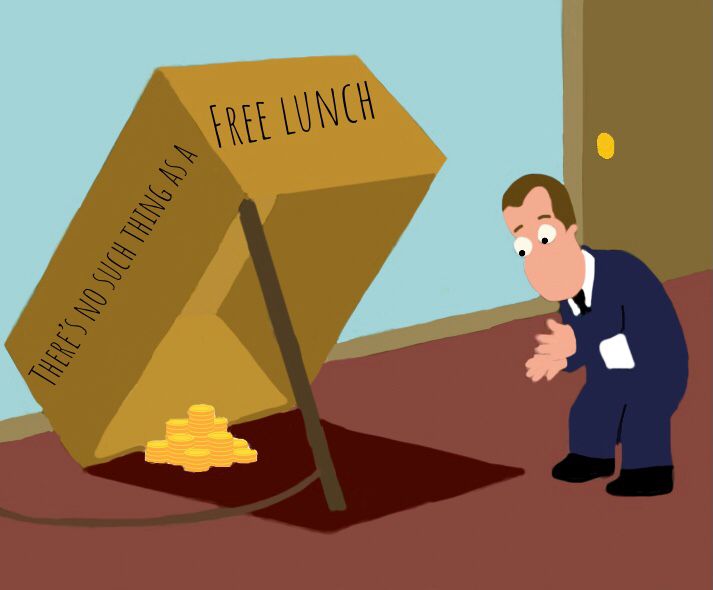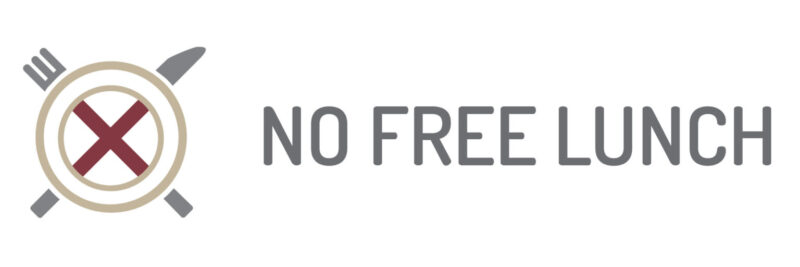Origin of the phrase ‘there’s no such thing as a free lunch phrase’.

One of the first known appearances of the no free lunch phrase in print came from ‘American Notes’ written by Rudyard Kipling of Jungle Book fame and published in 1899.
American Notes can be thought of as a politically incorrect Bill Bryson-Esque travelogue capturing Kipling’s reflections on life in some of America’s rapidly growing cities as the 20th century approached.
Viewed through the filter of the colonialist prejudices Kipling developed in India, American Notes captures the sense of opportunity bristling in a young nation but sneers at the hustle:
..came upon a bar-room full of bad Salon pictures, in which men with hats on the backs of their heads were wolfing food from a counter. It was the institution of the “free lunch” I had struck. You paid for a drink and got as much as you wanted to eat. For something less than a rupee a day a man can feed himself sumptuously in San Francisco, even though he be a bankrupt.
Rudyard Kipling, American Notes
The Free Lunch saloon ruse
Kipling’s placed the phrase ‘free lunch’ in speech marks to make it clear he was using it sarcastically.
The complimentary food was high in salt content, creating a thirst that customers inevitably paid to quench with beer. The net outcome of this so-called free lunch was, therefore, profitable for the saloon and far from free for the customer.
This type of ‘free lunch’ promotion became widespread, deceiving the working class to fill their bellies in bars on Main Street. At the same time, on Wall Street, the emerging middle class ploughed their profits from the era known as the Gilded or Golden Age in the belief that the growing economy would grow indefinitely, providing a free lunch to investors in the stock market.
Of course, It couldn’t, with America’s economy nosediving into the Great Depression triggered by the Wall Street Crash in 1929. That generation wasn’t the first or the last to be seduced into thinking that economic gravity could be defeated.
Free Lunch term as an early meme
The use of the phrase ‘there is no such thing as a free lunch’ gradually spread through society as what today we’d recognise as a meme.
The meme began appearing more regularly in newspapers, eventually contracting to an acronym – TANSTAAFL – that appeared in Life Magazine in 1961 (there ain’t no such thing as a free lunch) or equally common, TINSTAAFL (there is no such thing as a free lunch).
No free lunch origin in science fiction
The wider cultural use of the ‘no free lunch’ concept received a significant boost from the novel ‘The Moon is a harsh mistress‘ written in 1966 by Robert Heinlein, more famous for Starship Troopers.
The Little Oxford Dictionary of Quotations credits the initial mention in Heinlein’s excellent science-fiction novel as the first printed appearance of the no free lunch phrase.
Inspired by the origin of the no free lunch phrase in US depression-era salty-peanut saloon promos, Heinlein employed the idiom in a bar room scene involving the novel’s main protagonist, Manuel Garcia O’Kelly-Davis, a computer technician turned revolutionary and a lunar tourist.
tanstaafl” means “There ain’t no such thing as a free lunch”….pointing to a Free Lunch sign across the room ‘or these drinks would cost half as much…..anything free costs twice as much in long run or turns out worthless.
The Moon Is A Harsh Mistress” Robert Heinlein, 1966
Heinlein may have relocated the Depression-era marketing ruse several thousand miles into space and 150 years forward in time, but the no free lunch meaning remains exactly the same. In fact, the entire novel explores the concept in a subtle and fascinating way.
No free lunch on the Moon
The ‘Moon Is A Harsh Mistress‘ is set on the Moon in the year 2075, which serves as a penal colony for convicts and political dissidents.
Colonists are allowed to live ‘free’ on the understanding that they supply Earth with wheat which can be cultivated on the Moon thanks to advances in technology.
What science hasn’t solved, however, is the physiological impact of zero-gravity life on the human body, making returning to Earth impossible.
This quirk of the lunar environment turns six months on the Moon into an effective life sentence, as past that point, returning to Earth can be fatal.
Heinlein’s plot shows that even in 2075, Terrans (the nickname for Earth’s inhabitants) think they have found a way to avoid the law of Tinstaafl. Export criminals and subversives and get a constant supply of heavily subsidised lunches delivered by catapult.
Without spoiling the novel, things don’t quite work out that way, which shouldn’t surprise anyone because…well Tinstaafl.
Origin of no free lunch in economics
Another book gave the no free lunch concept a much wider audience. “There is no such thing as a free lunch” by economist Milton Friedman, was published in 1975. A year later, Friedman received the Nobel Prize for economics.
The book is a collection of Friedman’s essays on public policy, whose central theme is exposing the myth that the government can provide goods and services at no one’s expense. Hence the title.
Friedman believed that markets needed to be free to function efficiently, but his economic philosophy was used to justify repressive right-wing politics, making Friedman a controversial figure.
The lectures he gave in Chile at the request of the notorious dictator Augustine Pinochet were particularly damaging to his reputation.
Though a free-market economist and critical of money-printing, Friedman derided the gold standard and Austrian economists who argued for its return.
He believed in a combination of flexible exchange rates and firm domestic monetary rules. Friedman also advocated for a shock doctrine of reducing public spending, shrinking government and opening up markets as the route to prosperity.
His monetarist philosophy was widely exported to struggling economies throughout the 80s with largely disastrous consequences. Just read the ‘Shock Doctrine’ by Naomi Klein.
No free lunch & machine learning
Alongside its use in explaining the fundamental principles of scarcity, choice and opportunity cost in economics, the no free lunch idea has been applied to machine learning.
The no free lunch theorem developed by mathematicians David Wolpert and William Macready in 1997 states that “all optimization algorithms perform equally well when their performance is averaged across all possible problems.”
Dumbed down, the no free lunch theorem pushes back on the idea that machine learning algorithms could be optimised for success.
FAQs
One of the first known appearances of the phrase no free lunch in print came from ‘American Notes’ written by Rudyard Kipling of Jungle Book fame, and published in 1899.
The no free lunch theorem developed by mathematicians David Wolpert and William Macready in 1997 states that “all optimization algorithms perform equally well when their performance is averaged across all possible problems.”
No Free Lunch
There is no such thing as a free lunch, but if you’re hungry to find out why, we’re here to help.
You can learn the meaning and origin of the no free lunch concept, as well as the broader philosophy behind the idea that nothing can ever be regarded as free.
We look at our relationship with money and truth, examining all of the supposed shortcuts, life hacks and get-rich-quick schemes.
